Hamachi Crudo is a delicate Japanese appetizer made from raw yellowtail. Similar to sashimi, the fish is sliced thin and dressed in a bright ponzu and sweet chili sauce vinaigrette, topped with a quick-pickled red onion and cucumber garnish. Chef Takeo Moriyama of Kemuri Japanese Baru in Redwood City, California, generously shared this recipe for his popular Hamachi Crudo with JOC readers.

If you enjoy sashimi and new flavors, you need to make this Hamachi Crudo recipe at home! It is a special recipe shared by Chef Takeo Moriyama of Kemuri Japanese Baru, a modern Japanese izakaya restaurant specializing in creative small plates in California.
Imagine my surprise when Chef Moriyama invited me to collaborate on sharing his fan-favorite dishes with Just One Cookbook readers. We are a lucky bunch! Here, thinly sliced sushi-grade hamachi is bathed in a bright citrusy sauce and garnished with unexpected toppings. The fish itself is super fresh and buttery, and each bite is an explosion of flavors.
While this hamachi crudo looks fancy, I want to assure you that it is actually easy and takes only minutes to put together. Let us show you how to create this amazing appetizer at home!

Table of Contents
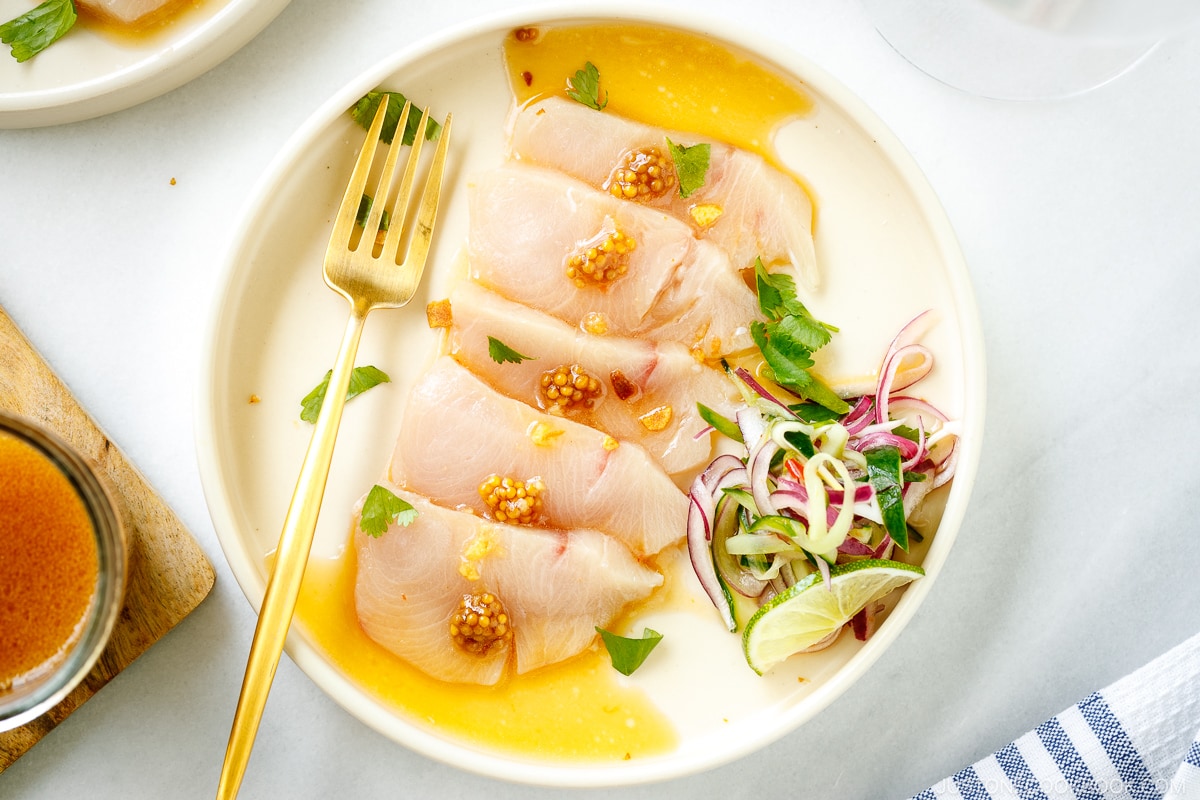
What is Hamachi Crudo?
Hamachi crudo is a seafood appetizer consisting of yellowtail sashimi dressed in a refreshing vinaigrette sauce and various toppings. As the name implies, the dish is a modern fusion of Japanese and Italian/Spanish cuisines, where it takes inspiration from Japanese sashimi and Italian carpaccio dishes.
Hamachi refers to yellowtail (aka amberjack or “buri”), while crudo means “raw” in Italian and Spanish and also refers to any dish of uncooked ingredients, including seafood, fish, meat, and sometimes vegetables that are dressed with olive oil and citrus-based dressing.
In the US, you’ll find hamachi crudo on the menus of high-end and casual restaurants that serve creative dishes. It is considered a common and popular dish in places like California and Hawaii, where fresh seafood is abundant. Each chef would prepare the dish with his/her own take on citrus-based dressings and toppings.
I’ve tried hamachi crudo which is dressed with Japanese flavors such as sesame oil, yuzu, and rice vinegar, and the ones with Italian ingredients such as olive oil, lemon juice, shallots, and capers.
Today, however, Chef Moriyama brings us his unique twist of hamachi crudo, where he marries Japanese flavors with seasonings from other cuisines. He takes the ingredients to bold new heights without compromising on the simplicity of the dish. You’ll be delighted by the bright flavors and the creative combinations.
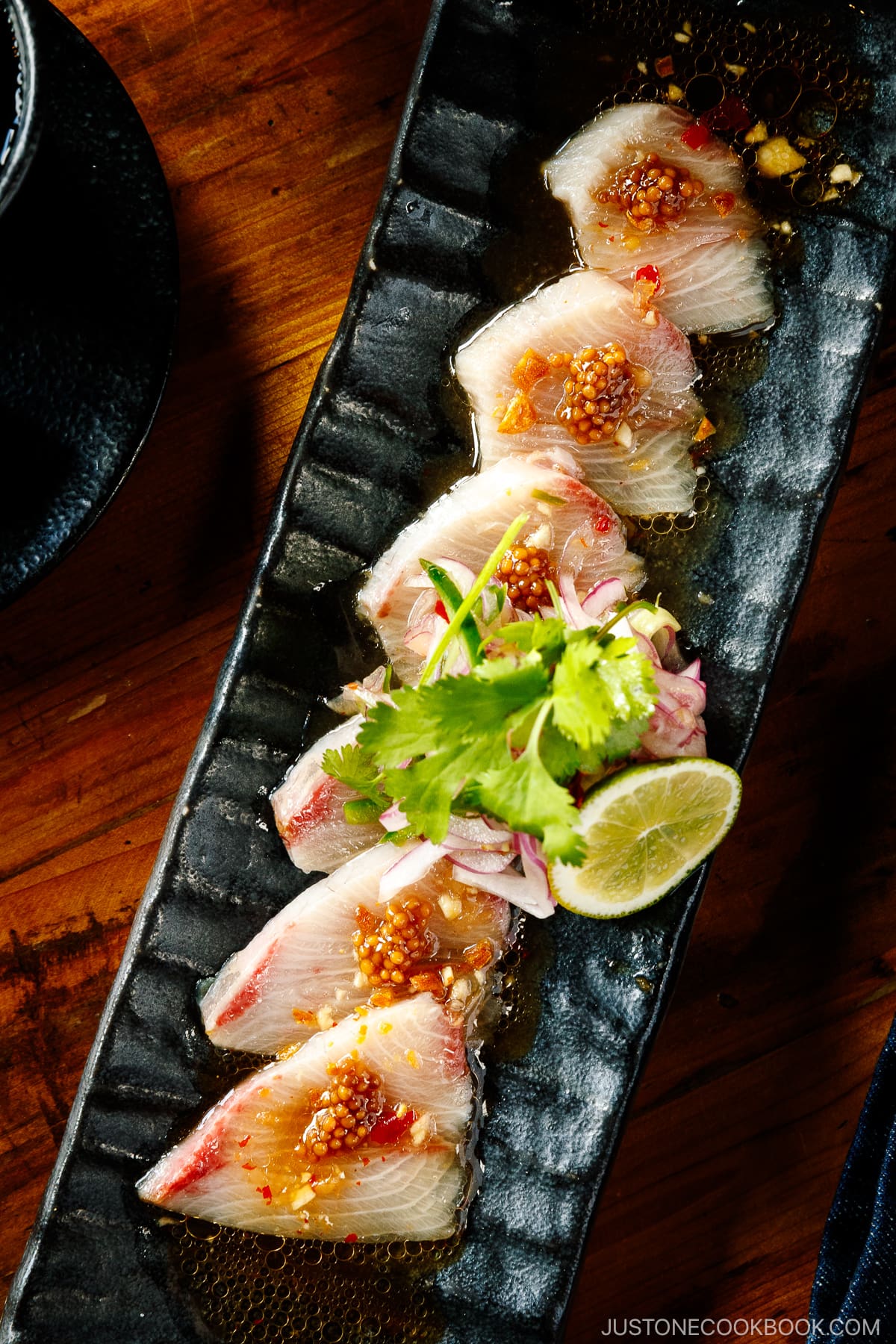
How to Make Hamachi Crudo
Ingredients You’ll Need
- Sashimi-grade yellowtail (hamachi)
- Vegetables and herbs: red onion, cucumber, jalapeño, garlic, and cilantro
- Condiments: Sweet chili sauce, fish sauce, rice vinegar, yuzu kosho, ponzu, non-oil aojiso dressing, and neutral-flavored oil.
- Others: Lime, sugar, kosher salt, black pepper, and fried garlic chips (homemade or store bought)
Ingredient Substitutions & Variations
- Yellowtail (hamachi) – If sashimi-grade yellowtail is not available, try other sushi-grade fish such as amberjack (kanpachi), striped jack (shimaaji), or red snapper (tai).
- Sweet chili sauce and fish sauce – You’ll be using these two condiments for both the quick pickled vegetables and the hamachi dressings. Don’t skip them as they are the key flavors for this dish. You can find it at any Asian grocery store and international aisle of your local grocery store.
- Yuzu kosho – I use this amazing Japanese condiment quite often in my recipes and some of you may have purchased it on Amazon. It’s spicy, citrusy, salty, and with a deep umami flavor from the fermentation. I get my favorite bottle at a Japanese grocery store.
- Ponzu – Ponzu or citrus soy sauce is a common Japanese condiment that we use in our cooking or dipping sauce. You can easily purchase it at Japanese and Asian grocery stores, on Amazon, or you can make it from scratch.
- Non-oil aojiso dressing – This was my favorite dressing when I was in high school and I was pleasantly surprised to see it is used in Chef Moriyama’s dressing recipe! You can get it at a Japanese/Asian grocery store. You can also substitute it with ponzu.
Overview: Cooking Steps
- Prepare the quick-pickled vegetables by making the pickle brine, slicing the vegetables, and mixing them all together.
- Prepare the hamachi dressing and slice the sashimi-grade hamachi.
- Assemble the hamachi and garnish it with Quick-Pickled Vegetables on top.

Hamachi Crudo Cooking Tips
- Pickled vegetables and hamachi dressing can be made ahead of time. Refrigerate the vegetables for up to 1–2 days and the dressing for up to 3–4 days.
- Thinly slice the sashimi-grade yellowtail, roughly ¼ inch (6 mm) thick. You should be able to enjoy a slice of yellowtail along with the toppings in one bite. You shouldn’t have to bite or cut in half before eating it.
- Slice the chilled yellowtail and prepare the dish right before serving. The raw hamachi should be served chilled and not at room temperature.

What to Do with Leftovers
- Hamachi Dressing – Use the dressing for other types of sashimi-grade fish and seafood such as salmon and scallops or cooked shrimp.
- Quick-Pickled Vegetables – Top on grilled steak or enjoy it with a leafy green salad.
- Sashimi-Grade Hamachi – It‘s best to consume raw yellowtail fish as soon as possible while it‘s fresh; if you have any leftovers, use it in other recipes like Yellowtail Roll (Negihama Maki), Mosaic Sushi, or Miso-Marinated Hamachi Bowl.

Dining at Kemuri Japanese Baru in Redwood City
Located in downtown Redwood City, California, Kemuri Japanese Baru specializes in creative Japanese izakaya dishes and drinks. It is our favorite local restaurant as the authentic flavors and delicious combinations remind us of restaurants in Japan. We’re so glad that it’s right here in our backyard. You’d need to stop by Kemuri if you are in the area.
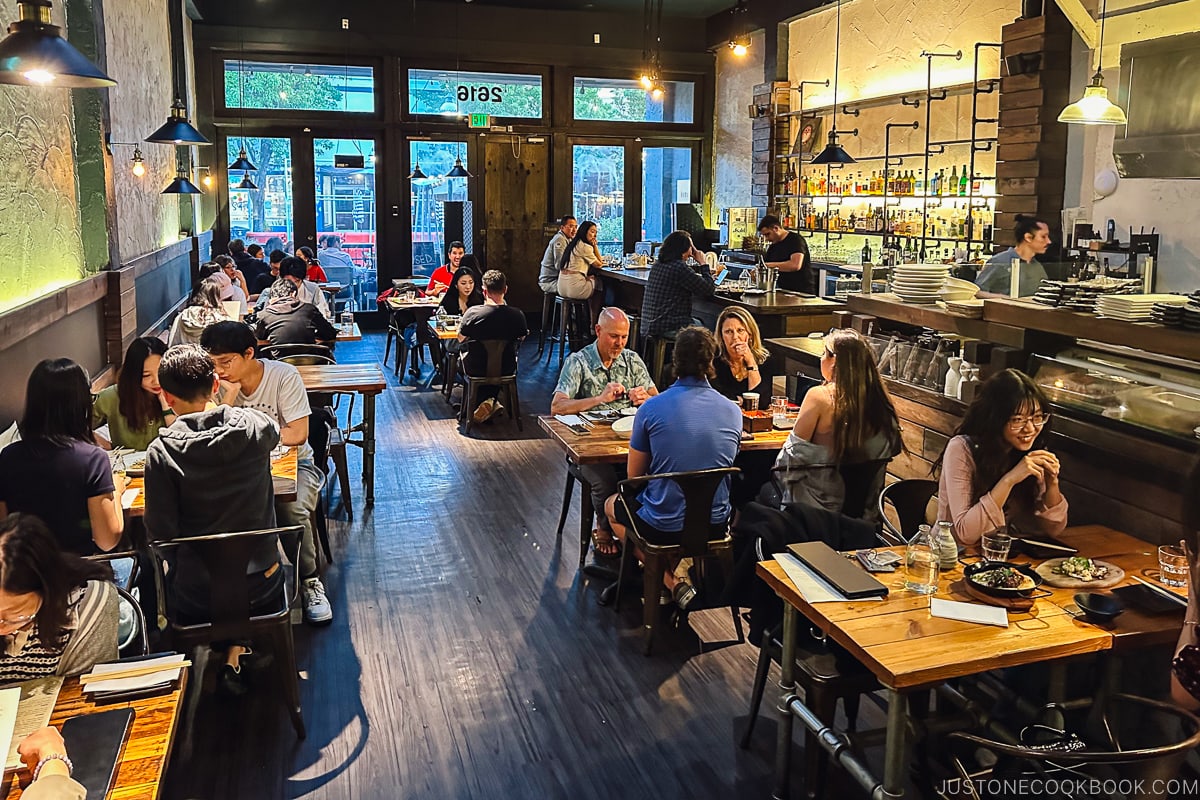



Our favorite dishes from the restaurant include:
- Umami Edamame
- Kemuri Ceviche
- Hamachi Crudo
- Kemuri Green Salad
- Crispy Chicken Karaage
- Smoked Hamachi Kama
- Corn Tempura
- Garlic Rice & Wagyu Steak Paella
- Oxtail Udon
- Yaki Oni Benedict
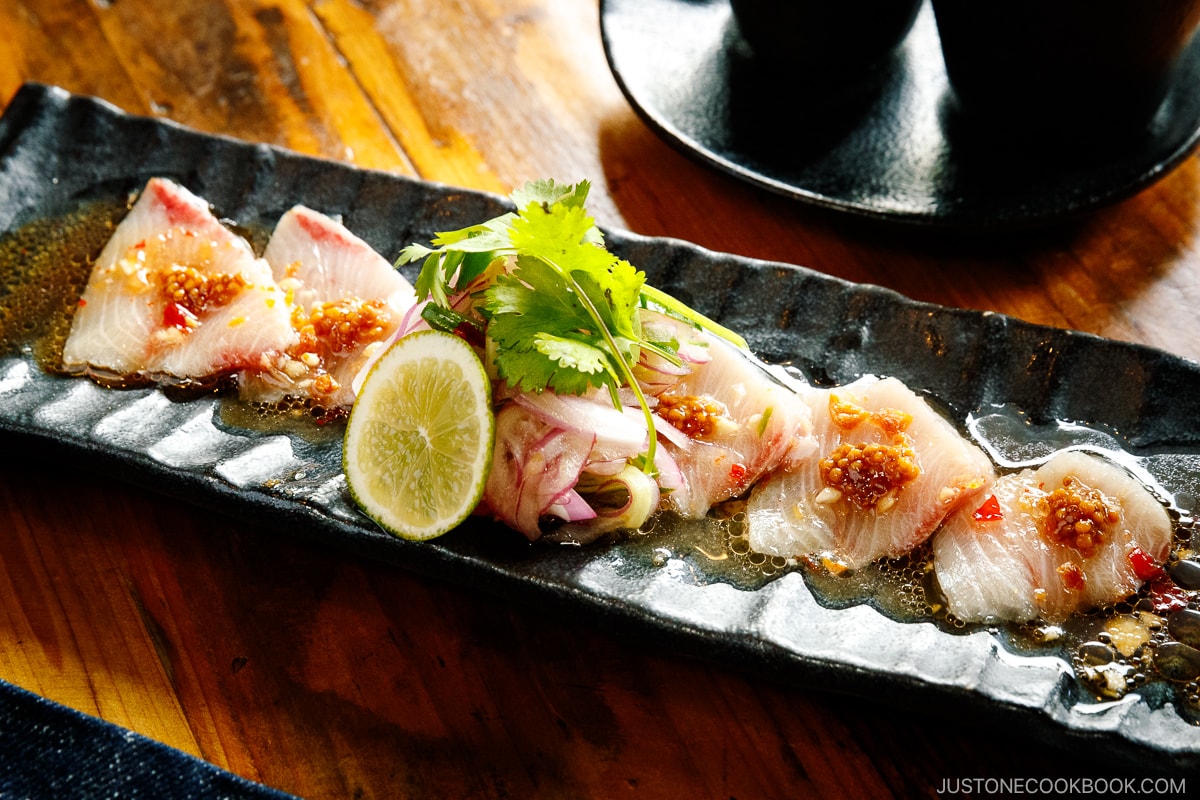
Wish to learn more about Japanese cooking? Sign up for our free newsletter to receive cooking tips & recipe updates! And stay in touch with me on Facebook, Pinterest, YouTube, and Instagram.

Hamachi Crudo
Video
Ingredients
For the Pickle Brine
- 2 tsp sweet chili sauce
- 2 tsp fish sauce
- 1 Tbsp sugar
- 1 Tbsp rice vinegar (unseasoned)
- ½ tsp yuzu kosho (Japanese citrus chili paste) (you can purchase it at Japanese grocery stores or on Amazon)
- juice of ½ lime
For the Quick-Pickled Vegetables
- ½ red onion
- ½ Persian cucumber
- ½ jalapeño pepper
For the Hamachi Dressing
- 1 Tbsp sweet chili sauce
- 1 Tbsp fish sauce
- 1 Tbsp non-oil aojiso dressing (you can substitute 1 Tbsp of this dressing with ½ tsp of ponzu)
- 5 tsp ponzu
- 2 Tbsp water
- 2 tsp sugar
- 1 clove garlic
- 3 Tbsp neutral oil
For the Hamachi
- ½ lb sashimi-grade yellowtail (hamachi) (can substitute it with sashimi-grade amberjack (kanpachi), striped jack (shimaaji), or red snapper (tai))
- ⅛ tsp Diamond Crystal kosher salt
For the Toppings
- 1 Tbsp of crushed fried garlic chips (fry thinly sliced garlic (6–8 cloves) in ¼ cup (60 ml) neutral-flavored oil for 3 mins on medium-low heat; you can also purchase it on Amazon)
- Golden Mustard (optional; you can buy it at Kemuri Japanese Baru or here)
- 1 Tbsp of chopped cilantro (coriander)
- 1 slice lime
Instructions
To Make the Quick-Pickled Vegetables
- Gather all the ingredients for the pickle brine and vegetables.

- In a medium bowl, add the 2 tsp sweet chili sauce, 2 tsp fish sauce, 1 Tbsp sugar, 1 Tbsp rice vinegar (unseasoned), and ½ tsp yuzu kosho (Japanese citrus chili paste) for the pickle brine. Then, add the juice of ½ lime into the bowl and mix it well together.

- Cut ½ red onion lengthwise into very thin slices. You can also use a mandoline slicer (I love my mandoline slicer). Tip: I learned from the chef that when you start slicing the onion from the edge, slice it at an angle (left photo) so the first few slices do not have thick edges.

- Cut ½ Persian cucumber in half lengthwise. Using a spoon, remove and discard the cucumber seeds. Then, cut the cucumber lengthwise into very thin slabs and then thin julienned strips.

- Cut ½ jalapeño pepper lengthwise into very thin slabs and then thin julienned strips. You may want to wear a glove for this step to avoid irritation to your skin and eyes (optional). Tip: For less heat, first quarter the pepper lengthwise and remove the ribs and seeds before cutting it into strips.

- Add the three vegetables you‘ve just cut to the pickle brine in the bowl. Then, toss the vegetables in the sauce to coat them well. Set the vegetables aside while you prepare the rest of the ingredients. Tip: You can make this ahead of time; prepare and refrigerate up to 24 hours in advance.

To Prepare the Hamachi and Dressing
- Gather ½ lb sashimi-grade yellowtail (hamachi) and dressing ingredients.

- In a small bowl, add 1 Tbsp sweet chili sauce, 1 Tbsp fish sauce, 1 Tbsp non-oil aojiso dressing (or ponzu substitute), 5 tsp ponzu, 2 Tbsp water, 2 tsp sugar, 1 clove garlic, and 3 Tbsp neutral oil for the hamachi dressing and whisk all together.

- If your sashimi-grade hamachi fillet has skin, remove it (see this video). Using a sharp knife, cut the fillet against the grain into thin slices ¼ inch (6 mm) thick.

To Plate and Serve
- Gather all the ingredients for the toppings.

- Lay the hamachi slices, overlapping them slightly on one corner, across a serving plate. Lightly sprinkle the hamachi with ⅛ tsp Diamond Crystal kosher salt. This draws out moisture from the fish, which results in more concentrated flavors. Spoon some of the hamachi dressing on the center of each slice, leaving some parts of the sashimi undressed with the sauce.

- Sprinkle 1 Tbsp of crushed fried garlic chips on top of the hamachi slices. If using the golden mustard (optional), add a small dollop of Golden Mustard to each slice. Mound a spoonful of the pickled vegetables on top of the hamachi at the center of the plate. Finally, garnish with 1 Tbsp of chopped cilantro (coriander) and 1 slice lime. The Hamachi Crudo is ready to serve.

To Store
- Store any leftover pickled vegetables and hamachi dressing in separate containers. Refrigerate the vegetables for up to 1–2 days and the dressing for up to 3–4 days. It‘s best to consume raw yellowtail as soon as possible while it‘s fresh; if you have any leftover, use it in other recipes like Yellowtail Roll (Negihama Maki), Mosaic Sushi, or Miso-Marinated Hamachi Bowl.
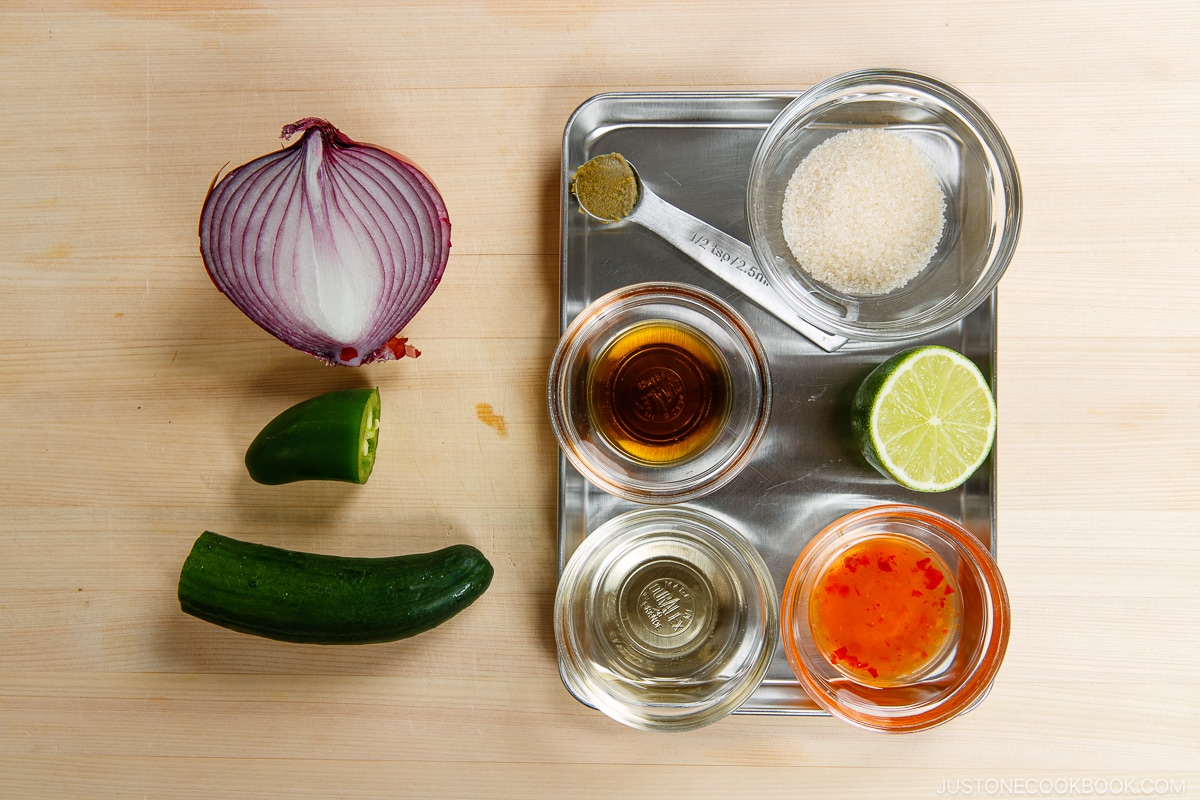










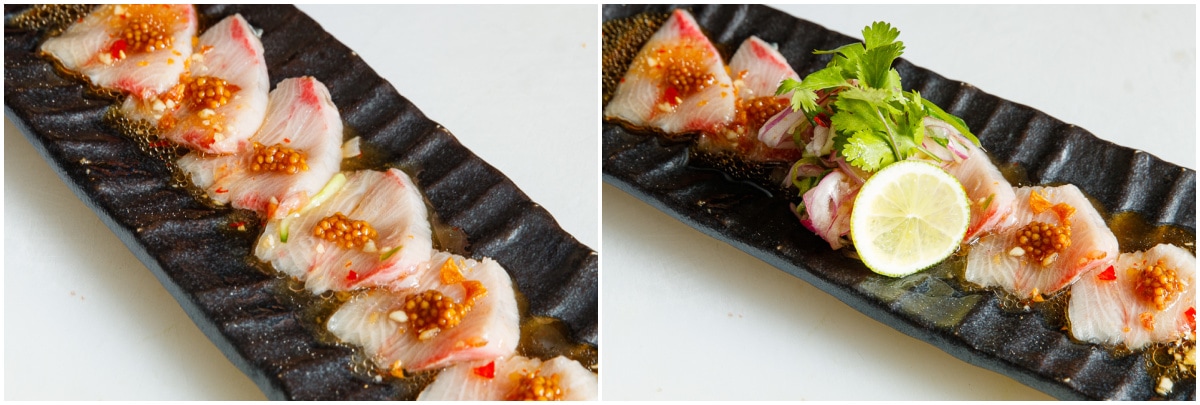










How do we order the golden mustard shipped in California?
Hi Joy! I think you can buy from this shop: https://ibspot.com/products/golden-mustard-black-140g
I tried there but looks like they can’t deliver to California after I go to check out.
Amazing recipe. The pickled vegetables held the right amount of spice (I took out the seeds of Jalapeño) I used Amber Jack Belly sliced thin, yuzu paste a necessity. For topping the fish I used ponzu, fresh cilantro, Meyer lemon zest and Kizami Wasabi. derishasu!! Arigato!!
Hi Miranda! Thank you for reading Nami’s post and for your kind feedback.
We are glad to hear you enjoyed the dish.
Happy Cooking!🫶🏻
Outstanding! Such a complexity of flavors in the sauce and it worked so well with hamachi. I needed to get the ingredients that I do not usually keep in my pantry, but the trip to Japantown was well worth it. Couldn’t find the Golden Mustard, so served it without, but will try to get it from Kemuri for the next time. Thank you!
Hi Jola! This Golden Mustard is quite expensive ($30-40 jar I think) but it is SO delicious. If you visit Kemuri, try this dish there, taste the mustard and think about purchasing there. It’s a great gift too. Thanks so much for trying this recipe!
looks deelish. ok to substitute fresh tuna?
Hi Nicole! Usually at restaurants, more bland white fish are used for crudo so that you can taste the sauce. I’ve never seen tuna being used crudo before. Chef’s recommendation is included in the note in the recipe card: can substitute it with sashimi-grade amberjack (kanpachi), striped jack (shimaaji), or red snapper (tai).